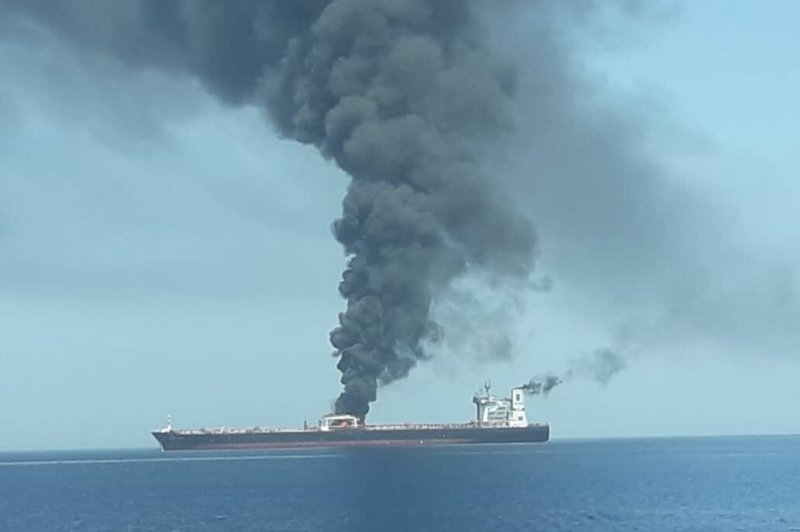A Norwegian oil tanker is seen on fire Thursday in the Gulf of Oman. Photo by IRIB News/EPA-EFE
June 13 (UPI) -- The United States released a video Thursday it says shows an Iranian Navy boat removing an unexploded mine from the hull of one of two oil tankers attacked in the Gulf of Oman.
U.S. Secretary of State Mike Pompeo blamed Iran for the attack earlier Thursday based on the types of weapons used, calling it a "blatant assault" on the two vessels. He said the attacks are a threat to international peace and represent an unacceptable escalation of tension by Iran.
"Iran is lashing out because the regime wants our successful maximum pressure campaign lifted," he said, referencing U.S. sanctions on Iran.
In the video posted by U.S. Central Command, a boat with several men aboard can be seen sidling up parallel to the MT Kokuka Courageous. A man, standing on the boat's bow, then can be seen removing an object from the Kokuka Courageous's hull that USCENTCOM says is an "unexploded limpet mine."
USCENTCOM said the removal of the mine occurred hours after the USS Bainbridge had arrived at the location of the attack.
Capt. Bill Urban, lead spokesman for USCENTCOM, said the United States does not want to engage in another conflict in the Middle East but it is ready to protect itself and its interests.
"Today's attacks are a clear threat to international freedom of navigation and freedom of commerce," he said in a statement. "The U.S. and the international community stand ready to defend our interests, including the freedom of navigation."
The two tankers -- the Japanese-operated Kokuka Courageous and the Norwegian-flagged MT Altair -- were attacked early Thursday morning in international waters in the Gulf of Oman and were approximately 10 nautical miles apart when the U.S. Navy received separate distress signals -- one at 6:12 a.m. and the other at 7 a.m. -- regarding the alleged attacks.
The Navy's Fifth Fleet, which is stationed in Bahrain, was the first to respond, stating in a statement shortly after the attack occurred that "U.S. Navy ships are in the area and are rendering assistance."
In all, 43 crew members were rescued from both tankers.
The International Association of Independent Tanker Owners, which the owners of two damaged vessels are members of, said that attack appears to be "well-planned and coordinated."
It said the vessels suffered explosions "at or below the waterline, in close proximity to the engine room."
INTERTANKO Chairman Paolo d'Amico said he is now "extremely worried" about crews traveling through the Strait of Hormuz, where some 20 to 30 percent of the world's crude oil passes through.
"If the waters are becoming unsafe, the supply to the entire Western world could be at risk," he said.
Jonathan Cohen, acting U.S. ambassador to the United Nations, told the U.N. Security Council that Iran was responsible for the attacks.
"No proxy group in the area has the resources or skill to act with this level of sophistication," he said. "Iran, however, has the weapons, the expertise and the requisite intelligence information to pull this off."
He said he expected the Security Council to watch the situation and expects there to be further conversations ahead while calling on Iran to return to the negotiating table.
Alireza Miryousefi, head spokesman of Iran's mission to the U.N., denied the allegations and called Cohen's comments part of an "Iranophobic campaign."
"Iran categorically rejects the U.S. unfounded claim with regard to the 13 June oil tanker incidents and condemns it in the strongest possible terms," he said in a statement published on Twitter.
He also accused the United States of committing so-called false flag operations and plots in the region while stating Iran "expresses concern over the suspicious incidents" of the attacks on the oil tankers.
Meanwhile, Iranian Foreign Minister Mohammad Javad Zarif said on Twitter that "suspicious doesn't begin to describe what likely transpired this morning."
He said before the video was posted by USCENTCOM that the United States had jumped to conclusion in blaming Iran without proof, stating it was attempting to "sabotage diplomacy" while committing "economic terrorism" against Iran.
Zarif tweeted that the attacks occurred while Japanese Prime Minister Shinzo Abe was in a meeting with Ayatollah Khamenei. One of the tankers is operated by the Japanese.
The incident comes a month after four oil tankers, two of which were Saudi, were sabotaged in the gulf.
In late May, national security adviser John Bolton blamed Iran for the attack. Tensions in the Middle East have been high following the Trump administration canceling waivers on April 25 that allowed countries to buy Iranian oil without violating sanctions. In apparent retaliation, Iran partially withdrew from a landmark six-nation nuclear accord.
Oil futures climbed 4 percent following news of the incident, from a near five-month low, Bloomberg reported.















